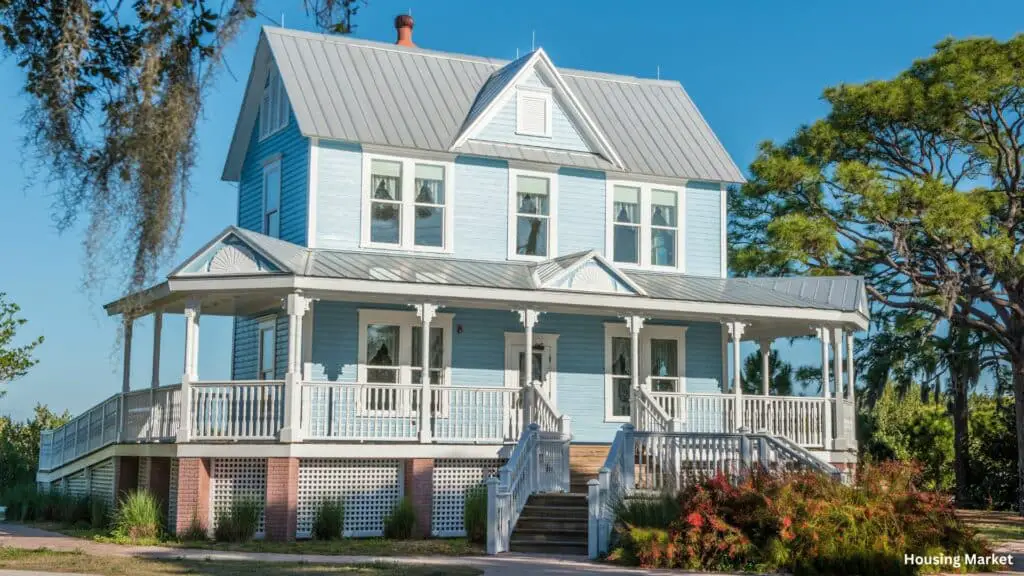As of the first quarter of 2024, the average house price in the United States reflects a nuanced landscape of real estate values across different states. According to recent data from the Federal Reserve Bank of St. Louis, the median home sales price nationwide stands at $420,800, which represents a slight decrease from previous quarters.

This article delves into the state-by-state breakdown of housing prices, offering insights into how economic factors and market trends are shaping the cost of homeownership across the country.
National Housing Price Trends
The median home sales price in the U.S. declined by 0.6% to $420,800 in the first quarter of 2024 from $423,200 in the last quarter of 2023. This trend is part of a broader cooling in the housing market, which saw prices increase significantly from mid-2021 through late 2022.
Factors influencing these dynamics include changing mortgage rates and demographic shifts, notably increased homeownership among millennials spurred by the COVID-19 pandemic and subsequent economic changes.
State-by-State Analysis of Average House Price in 2024
The disparity in housing prices across states is stark. Hawaii tops the list as the most expensive state with an average home value of $856,327, while West Virginia is the most affordable, with homes averaging just $160,044. These figures, derived from the Zillow Home Value Index, illustrate the varied landscape of housing affordability in the U.S.
| State | Q1 2024 average |
| Alabama | $225,579 |
| Alaska | $353,229 |
| Arizona | $429,787 |
| Arkansas | $202,520 |
| California | $782,695 |
| Colorado | $548,602 |
| Connecticut | $390,817 |
| Delaware | $385,331 |
| District of Columbia | $619,490 |
| Florida | $396,318 |
| Georgia | $326,078 |
| Hawaii | $856,327 |
| Idaho | $449,952 |
| Illinois | $256,138 |
| Indiana | $235,465 |
| Iowa | $213,206 |
| Kansas | $222,704 |
| Kentucky | $200,661 |
| Louisiana | $198,970 |
| Maine | $390,636 |
| Maryland | $413,065 |
| Massachusetts | $609,415 |
| Michigan | $238,220 |
| Minnesota | $330,258 |
| Mississippi | $177,699 |
| Missouri | $242,235 |
| Montana | $453,732 |
| Nebraska | $255,935 |
| Nevada | $430,849 |
| New Hampshire | $463,091 |
| New Jersey | $508,430 |
| New Mexico | $298,984 |
| New York | $458,072 |
| North Carolina | $328,181 |
| North Dakota | $252,426 |
| Ohio | $221,816 |
| Oklahoma | $202,848 |
| Oregon | $497,249 |
| Pennsylvania | $260,153 |
| Rhode Island | $449,550 |
| South Carolina | $292,948 |
| South Dakota | $297,384 |
| Tennessee | $316,473 |
| Texas | $303,352 |
| Utah | $518,241 |
| Vermont | $380,433 |
| Virginia | $384,026 |
| Washington | $588,986 |
| West Virginia | $160,044 |
| Wisconsin | $293,023 |
| Wyoming | $340,036 |
Economic Factors and Home Prices
The fluctuations in home prices are closely tied to economic indicators such as median household incomes and the proportion of that income that homeowners are likely to spend on housing.

States like California and New York, known for their high cost of living, also exhibit some of the highest home values, whereas states like West Virginia offer more affordable housing options in relation to local incomes.
Looking Ahead
As we move further into 2024, potential home buyers and investors should monitor these trends closely. Understanding the dynamics at play can help in making informed decisions about where and when to invest in real estate.

The average house price in various states provides more than just financial data; it reflects the economic health and priorities of regions. By keeping an eye on these trends, stakeholders can better navigate the complexities of the real estate market in 2024.
Related posts:
 Realtors: Coronavirus Starts Slowing Down Housing Market
Realtors: Coronavirus Starts Slowing Down Housing Market
 The Ultimate Guide for Successful Home Renovation Planning
The Ultimate Guide for Successful Home Renovation Planning
 When Will Be a Good Time to Buy a House in 2024: Unveiling the Ideal Season
When Will Be a Good Time to Buy a House in 2024: Unveiling the Ideal Season
 Best Home Warranty Companies: Your Top 12 Picks for 2024
Best Home Warranty Companies: Your Top 12 Picks for 2024
 KBIS 2024’s DesignBites 10 Kitchen and Bath Innovators
KBIS 2024’s DesignBites 10 Kitchen and Bath Innovators



